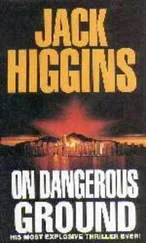The Manta’s passive sonar picked up two raps. That was the Master Chief saying everything was all right — if you could call being buffeted by freezing water all right.
“I’m increasing speed to eight knots.”
“Matching,” Davis answered.
Again Jerry slowly picked up the pace, and again the Master Chief signaled that all was well. Finally, the Manta and Huey reached ten knots as they made their way into Russian territorial waters.
The barge lay a mile and half away in ten fathoms of water. The bottom shelved rapidly near the barge, but this was as close as Memphis could get without crossing the twelve-mile limit. At five knots, that meant eighteen minutes just to reach the barge. Ten knots would halve that time, if the two could stand the ride.
Jerry waited to hear three taps on the Manta’s hull. That was the signal to slow down, or for trouble, but he heard nothing.
With the divers on the Manta’s back, he could now safely operate the active sonar to locate the barge. Jerry kept the number of transmissions down, just in case someone might be out there listening, and he only updated the barge’s position so that he wasn’t flying blind.
They found the barge quickly enough, and Jerry gingerly steered the Manta the last few hundred yards. He managed to bring it close alongside and watched in Huey’s camera as Reynolds and Harris detached themselves and then retrieved the tool bag. As soon as they were off, Jerry turned the Manta away from the barge. He began a tight thousand-yard circle, watching the passive display and praying that he wouldn’t detect anything.
The barge looked exactly the same, but the knowledge that two men were about to enter it made it much more menacing. Jerry watched the ROV’s camera as Emily took station above the barge’s open hatchway Her lights gave some general illumination, but both of Memphis divers had their own lights. Jerry could see them now swimming toward the edge of the open hatch. They stopped for a moment, and Jerry wondered if there was a problem. Then he realized they were just looking the situation over, like any prudent diver. They swam down into the hatch, and Jerry tried to remember the layout of the hold. Where were the obstructions? How much had the cargo shifted?
The hatch expanded in the screen, and Davis said, “I’m sending Huey in.” They’d all agreed earlier that she should do it, although there was some risk of complicating the divers’ situation. It would give them more light, as well as the all-important radiation detector and the camera.
As she gingerly navigated the ROV into the hold, the camera picked up Reynolds and Harris over in one corner, well clear and dead ahead. They were studying one of the metal crates. It was almost as long as Reynolds was tall, and at least three feet square. Metal clips ran around one edge. Lifting hooks implied some weight, as did the strips that reinforced the corners and sides.
After shining a light on all exposed sides, Reynolds tried to shift the crate slightly. It budged, but gave the impression of being heavy. He motioned to Harris, pantomiming tools, and swam over to the tool bag. He handed Harris a pair of pliers while the COB took out a large screwdriver.
They started working on the clips, wasting time as they searched in the darkness for the quickest way to open them. Reynolds discovered a way to pop them with the screwdriver and began working his way along the edge. Along with that Christmas-present feeling, Jerry wondered if it was a Pandora’s box. He couldn’t escape a mental image of the lid opening and a cloud of liquid waste escaping, poisoning the two with toxic chemicals and radiation before they could close it again.
As Reynolds finished releasing the clips, Harris moved aside as Emily pointed Huey right at the case. “The radiation count is still very low,” announced Emily. “I’m sending the ‘all safe’ signal.” Reynolds and Harris saw the lights blink once, and Harris held up his free hand, making an exaggerated thumbs-up gesture. So far, so good.
As they’d discussed, Harris swam away, to hover near the ROV. The idea was that if the crate did contain something deadly, only one of the divers would be exposed. Jerry watched the seconds tick by as Harris reached what they hoped was a safe distance, but they’d all agreed it was worth the time.
Reynolds wedged the edge of the screwdriver into the joint between the lid and the rest of the crate. He pounded on one end, and a thin stream of silvery bubbles appeared. He stopped for a moment and made a sweeping motion with his right hand, asking for Emily to take another radiation reading. Again, everything was within limits and she flashed the lights once. Facing the ROV, Reynolds gave the thumbs-up sign and returned his attention to the lid.
Working the screwdriver in, alternately wiggling it, and pounding on the end resulted in successively larger and thicker streams of bubbles until they merged into a solid mass of air that half-lifted the lid off. Jerry could see Reynolds’ surprised reaction and he backed off to give Emily some room to move Huey in a little closer and make yet another pass with the radiation detector. Huey’s lights flashed once and Reynolds waved Harris over. Emily backed the ROV away from the case to give the divers room to work.
This was why Jerry had wanted to make the dive. The COB and Harris could look in the crate. They knew what was in it, but nobody else on Earth did. Except for whoever put it there, Jerry corrected himself.
The two divers knew this, and Reynolds bent down and started heaving on one side, the side away from the camera. Harris quickly realized what the COB was after and started lifting from his end. The two men quickly tilted the crate so that it toppled over onto its side, turning the top toward the camera.
A rush of air bubbles didn’t obscure the view for more than a second. Emily automatically adjusted the lights and zoomed the camera to maximum magnification.
Framed by the rectangular box, a cone-shaped object lay in a cradle. It was about five feet long and two feet wide at the base. The wide end was flat, and narrowed to an almost needle-like point. It was dull green or black and its polished surface was marked by a few patches of white lettering near the base. They were looking at a full-up nuclear warhead, almost certainly a reentry vehicle for a ballistic missile.
Chills ran laps around Jerry’s spine and the sailors in the torpedo room either blasphemed or made improbable sexual suggestions. After a few moments, the phone talker’s voice in Jerry headphones said, “Captain Hardy wants your recommendations.”
I’ll bet he does, thought Jerry. Their mission orders had just changed and the trick was to figure out what they should now be. Jerry’s instant reaction was to grab it and get it back to the boat, but then he forced himself to think, Why?
Nuclear warheads hidden on the sea floor. Who’d hidden them there? Why? He doubted any of the cases carried luggage tags, but if they could examine the warhead, they’d get a lot more information than they had right now.
And they’d have to have proof. Photos or samples could be dismissed or denied. Jerry had a visual flash of that thing being wheeled into a press conference.
“We’ve got to have it,” jerry decided out loud, and realized that he’d spoken into the microphone.
“I’m glad you concur,” said Hardy’s voice acidly as he came onto the circuit. “I meant about how do we get it back to the boat.”
“Oh. Yessir,” Jerry answered. That was a much harder question to answer. The thing must weigh hundreds of pounds. Not even Reynolds could tuck it under one arm for the ride back.
Dr. Patterson was also on the circuit. “What if they disassembled it and just brought back the physics package?”
Читать дальше












